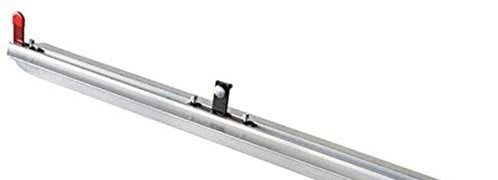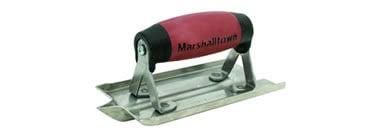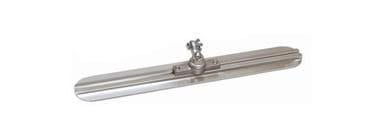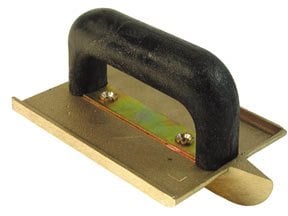- Concrete Tools Home
- Screeds
- Tampers
- Concrete Floats
- Concrete Edgers
- Groovers
- Trowels
- Fresnos
- Power Tools for Concrete
- Choosing the Best Tool for the Job
- Must-Have Tools for Exterior Concrete: The five tools outdoor concrete contractors can’t live without
- Five Must-Have Tools for Decorative Flooring Contractors Create eautiful decorative concrete floors with these five tools
- Five Must-Have Tools for Concrete Countertop Contractors
- Related Information:
- Pouring and Finishing Tool Videos: See demonstrations of floating, troweling, edging, and more
- Concrete Finishing Tips: Creating a high-quality slab
- Product Newsletter: Sign up today to receive monthly updates
Concrete Groovers & Jointers
Use these tools for creating control jointsJointing the concrete is accomplished by grooving tools (unless the slab will be sawcut later). The purpose is to control the location of cracks that may form when the slab "contracts" due to drying shrinkage or temperature changes.
Look inside tooled joints or sawcuts and you will see the concrete is cracked—The joint did its job and controlled where the concrete cracked. Joints are most often hand-tooled into sidewalks, driveways and patios and sawcut into floors, highways, and city streets.
MATERIALS, SIZES AND BIT DIMENSIONS FOR GROOVERS
Groovers are usually made of bronze or stainless steel and have a V-shaped bit that cuts the joint. Like edgers, they come with wood or comfort-grip handles.
The most common groover size is 6 inches long and 4 1/2 inches wide, but many other sizes are available, ranging from 2 to 8 inches wide and 3 to 10 inches long.
However, more important is the dimension of the bit, which can be anywhere from 1/2 inch to 2 inches deep and 1/8 to 1 inch wide. Bi-directional groovers are also available and have double-end bits that give you the flexibility to cut forward or backward.
 Kraft Tool Joint Groover
1-3/4" deep
Kraft Tool Joint Groover
1-3/4" deep
 Stainless Steel Groover
Allows for sharp grooves with leading edge.
Stainless Steel Groover
Allows for sharp grooves with leading edge.
 Kraft Concrete Float 24" x 3.25"
Lightweight magnesium float for small areas.
Kraft Concrete Float 24" x 3.25"
Lightweight magnesium float for small areas.
CONCRETE JOINTER BUYING TIPS
-
As with edgers, bronze or heavy-gauge stainless steel groovers will often deliver the best durability and performance. Some stainless steel tools come with highly polished finishes so they glide more easily through the concrete.
-
The bit depth of the groover should be at least one-fourth the slab thickness to create a sufficient plane of weakness along which the slab can crack. So if you plan to groove a 4-inch-thick sidewalk, be sure to buy a tool with a 1-inch bit depth.
-
For stand-up use, walking groovers are available with features similar to those of walking edgers. Or you can simply buy a special groover attachment that secures to your metal bull float or fresno trowel with thumb screws. Using more than one of these attachments on a float or fresno lets you cut multiple grooves in one pass.
AVERAGE GROOVER COSTS
For a 6x4 1/2-inch groover, you'll pay about $25 or more for bronze and as much as $35 for heavy-gauge stainless steel.
Get more information on joint layout and required joint depths.
More info: See our section on Concrete Admixtures for tips on controlling drying shrinkage cracking, and hot weather and cold weather concreting.





